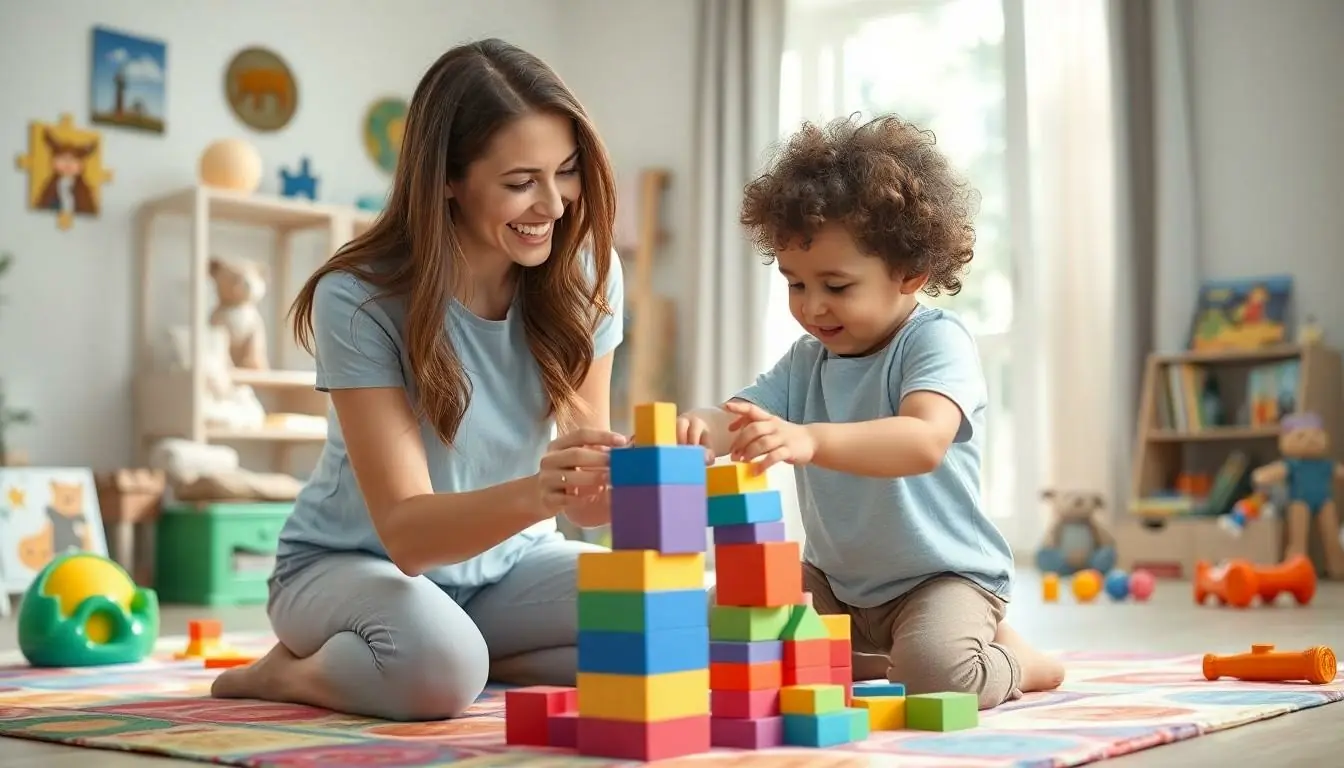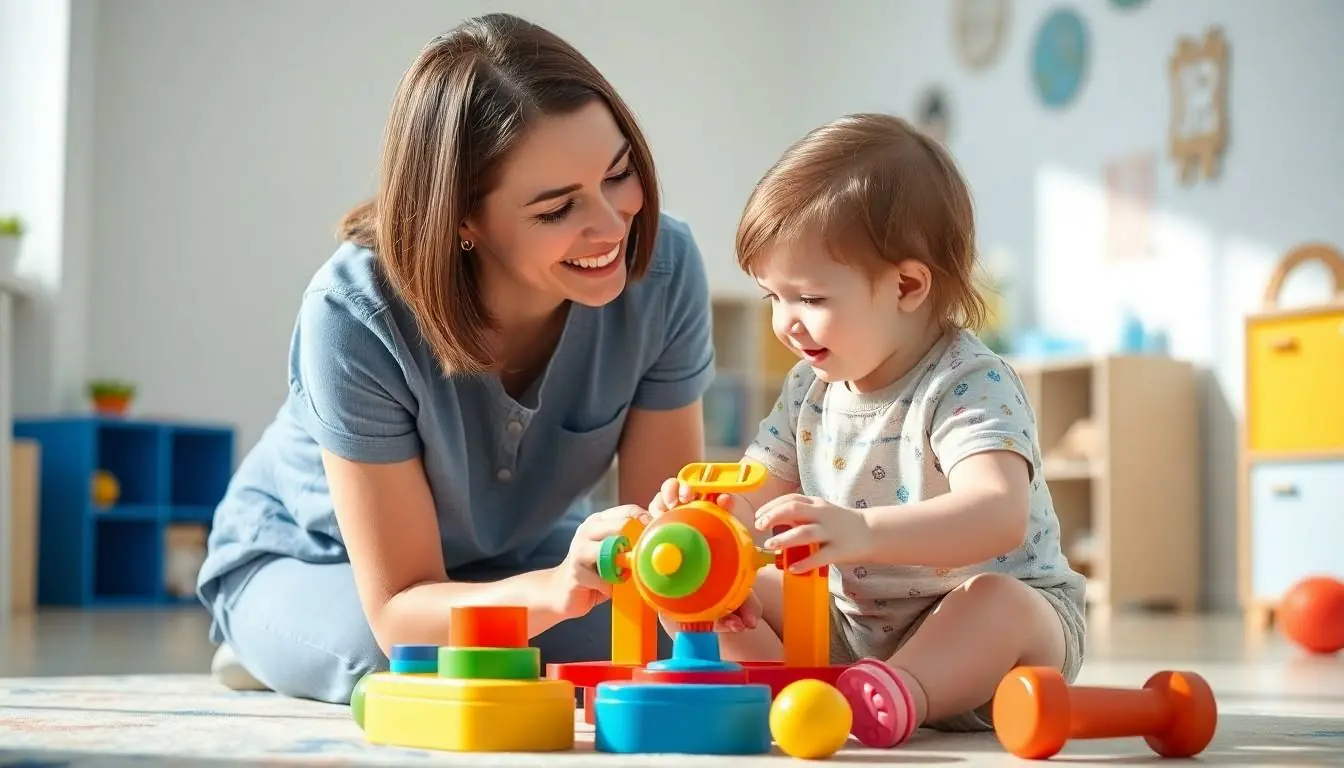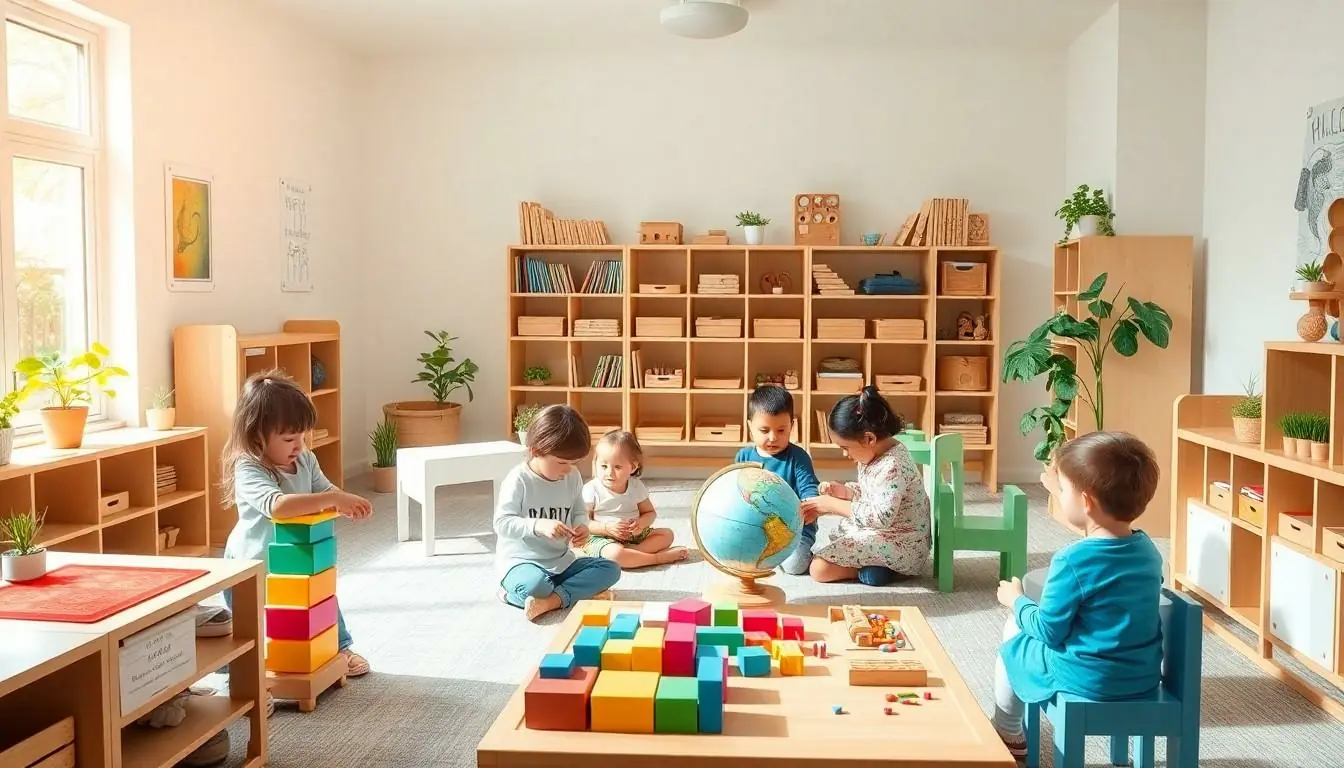Parenting a toddler feels like trying to negotiate with a tiny dictator who hasn’t quite mastered the art of rational thinking. One minute they’re sharing their snacks with everyone, and the next they’re having a meltdown because their banana broke in half. It’s a wild ride that leaves many parents wondering if they’ll ever get it right.
But here’s the good news: while there’s no perfect formula for raising a toddler, there are proven strategies that can make this chaotic phase more manageable. From handling those infamous temper tantrums to establishing routines that actually work, understanding toddler behavior is the first step toward maintaining sanity during these challenging yet precious years.
Table of Contents
ToggleUnderstanding Your Toddler’s Development Stages
Toddlers progress through distinct developmental phases between ages 1-3 years. These stages involve significant physical, cognitive and emotional changes that shape their behavior and abilities.
Physical Growth Milestones
Toddlers experience rapid physical development marked by key motor skill achievements. At 12-18 months, they master walking independently and begin running. Fine motor skills emerge as they grasp objects like crayons pencils to scribble. By age 2, most toddlers:
- Climb stairs with support
- Kick and throw balls
- Stack 4-6 blocks
- Use spoons and cups
- Remove simple clothing items
Their physical coordination improves steadily, enabling more complex movements like jumping, hopping and pedaling tricycles by age 3.
Cognitive and Emotional Changes
Toddlers undergo dramatic cognitive and emotional growth during this period. Their vocabulary expands from 50 words at 18 months to 300+ words by age 3. Key developmental markers include:
- Following 2-step instructions
- Identifying basic colors shapes
- Expressing emotions through words
- Understanding cause-effect relationships
- Developing self-awareness
- Beginning imaginative play
Memory and problem-solving abilities strengthen as they explore their environment. Emotionally, toddlers experience intense feelings while learning to regulate them. They display increased independence mixed with separation anxiety at different stages.
Setting Consistent Rules and Boundaries
Consistent rules create a structured environment where toddlers learn acceptable behavior patterns. Clear boundaries promote security while supporting developmental growth through predictable expectations.
Creating Daily Routines
Daily routines establish behavioral guardrails for toddlers through repetitive activities at set times. Morning routines include getting dressed, eating breakfast at 8 AM sharp followed by teeth brushing. Scheduled nap times between 1-3 PM prevent overtiredness that leads to meltdowns. Bedtime sequences starting at 7 PM with bath, pajamas, stories then lights out at 8 PM create calming transitions. Consistent meal times at 8 AM, 12 PM, 3:30 PM snack and 6 PM dinner regulate hunger-related mood swings. Regular outdoor playtime from 10-11 AM channels energy productively.
Establishing Clear Consequences
Logical consequences teach toddlers the direct impact of their actions through immediate feedback. Examples include:
- Removing toys for 5 minutes when thrown
- Taking brief timeouts (1-2 minutes) for hitting or biting
- Leaving the playground after refusing to take turns
- Ending activities early for dangerous behavior
- Pausing screen time when viewing limits are exceeded
- Skipping dessert for refusing to eat dinner
- Restricting privilege access until tasks like cleanup finish
Parents maintain eye contact while calmly explaining consequences using simple phrases like “When you throw toys, they go away.” Follow-through happens immediately without negotiation.
Effective Discipline Strategies for Toddlers
Disciplining toddlers requires consistent boundaries mixed with positive guidance. Effective discipline strategies focus on teaching appropriate behavior rather than punishment.
Positive Reinforcement
Positive reinforcement creates lasting behavioral changes in toddlers through specific praise feedback. Parents praise desirable actions immediately after they occur, such as “Great job putting your toys away” or “I like how you’re using gentle hands with the cat.” Rewarding good behavior increases its frequency, with effective rewards including sticker charts, extra playtime or special activities. Social rewards like high-fives clapping hands prove particularly effective for toddlers ages 1-3. The key lies in maintaining consistency with reinforcement timing offering praise within 5 seconds of the desired behavior.
Time-Out Techniques
Time-outs work effectively for toddlers over age 2 when implemented properly. The standard approach uses 1 minute of time-out per year of age, placing the child in a boring designated spot like a chair or step. Parents explain the reason for time-out calmly using simple phrases such as “No hitting. Time-out.” Time-outs start immediately after the behavior occurs keeping the duration brief – 2 minutes for a 2-year-old. The space remains free from toys stimulation distractions. After time-out ends parents briefly review why it occurred then return to normal activities without lengthy lectures.
Nurturing Communication Skills
Communication skills form the foundation of a toddler’s social development. Early language acquisition enables toddlers to express their needs effectively reducing frustration-based behaviors.
Teaching Basic Words and Phrases
Language development starts with simple nouns like “mama” “dada” “milk” or “ball.” Parents strengthen vocabulary by naming objects during daily activities such as meals playtime or bath routines. Repetition of common phrases like “all done” “more please” or “thank you” helps toddlers grasp language patterns. Picture books provide visual context for new words with parents pointing to images while saying corresponding words. Songs rhymes finger plays enhance word retention through engaging auditory experiences. Simple questions that require one-word answers encourage verbal responses: “Do you want water?” Creating opportunities for back-and-forth exchanges during daily activities builds communication confidence.
Handling Tantrums Constructively
Tantrums occur when toddlers lack words to express big emotions. Parents teach emotional vocabulary by labeling feelings: “You’re feeling mad because we can’t go outside.” Offering alternative ways to communicate prevents outbursts with options like pointing gestures or simple sign language. Maintaining calm steady voices during tantrums models emotional regulation. Redirecting attention to engaging activities shifts focus from triggers. Setting up quiet spaces gives toddlers safe zones to process emotions independently. Parents acknowledge feelings without giving in to demands: “I understand you want candy. We eat candy after dinner.” Consistent responses to tantrums establish clear communication patterns reducing their frequency over time.
Supporting Your Toddler’s Independence
Toddlers develop confidence through mastering new skills independently. Creating opportunities for safe exploration while teaching essential self-help abilities promotes their growing autonomy.
Safe Exploration Opportunities
A childproofed play area enables toddlers to explore freely without constant supervision. Install safety gates at stairs, secure furniture to walls, cover electrical outlets with guards. Create designated exploration zones with age-appropriate toys like stacking blocks, shape sorters or sensory bins. Set up low shelves with rotating activities to encourage independent play selection. Add stepping stools near sinks, tables or light switches to facilitate independent access. Designate a “yes space” – a fully safe room where toddlers can move, climb, crawl, jump without restrictions.
Building Self-Help Skills
Teaching self-help skills starts with daily care routines like handwashing, dressing or eating. Break tasks into small, manageable steps – pulling up pants, putting arms through sleeves, using utensils. Make activities accessible with child-sized tools such as lightweight cups, short-handled toothbrushes or easy-grip utensils. Create visual aids showing step-by-step processes for tasks like potty training or cleaning up toys. Allow extra time for practice during less rushed moments. Celebrate attempts at independence alongside successful completion. Focus on one skill at a time to avoid overwhelming the learning process.
Managing Common Toddler Challenges
Common toddler challenges require consistent strategies backed by research-based approaches. These evidence-based solutions address sleep disruptions picky eating patterns while maintaining a structured environment for optimal development.
Sleep Schedule Adjustments
Establishing a consistent bedtime routine creates predictable sleep patterns in toddlers. A calming sequence includes:
- Bath time at 6:30 PM to trigger natural sleep hormones
- Story reading for 15-20 minutes in dim lighting
- White noise machines set at 65-70 decibels
- Room temperature maintained at 68-72°F
Create a sleep-friendly environment with:
- Blackout curtains to block disruptive light
- A toddler-sized bed with familiar comfort items
- Clear boundaries about staying in bed
- Consistent 7:00 PM bedtime schedule
Picky Eating Solutions
Mealtime success depends on structured eating environments that promote healthy food relationships. Consider these proven strategies:
| Meal Component | Timing | Portion Size |
|---|---|---|
| Main meals | 3x daily | 2-3 tablespoons per food group |
| Healthy snacks | 2-3x daily | 1-2 tablespoons |
| Water breaks | 4-6x daily | 4-6 oz per serving |
- Serving new foods alongside familiar favorites
- Creating colorful plate presentations
- Offering finger-sized food portions
- Maintaining regular meal schedules
- Involving toddlers in meal preparation
- Modeling positive eating behaviors
Fostering Social Development
Social development forms a critical foundation for toddlers’ future relationships. Early social interactions shape communication skills emotional intelligence essential life skills.
Playdate Preparation
Successful playdates require strategic planning to create positive social experiences. Parents organize playdates in 60-90 minute intervals during their toddler’s most alert times. A childproofed space with duplicate toys reduces conflicts between children. The host parent prepares healthy snacks finger foods like cut fruit or crackers served at a designated time. Setting clear expectations with the visiting parent about supervision responsibilities schedules avoids confusion. A structured activity such as painting or playdough gives toddlers a focused starting point for interaction.
Sharing and Taking Turns
Toddlers learn sharing through guided practice consistent modeling. Parents demonstrate turn-taking during daily activities like stacking blocks or rolling balls. Simple timing tools like a 2-minute sand timer help toddlers understand when their turn ends begins. Praising specific sharing behaviors reinforces positive social interactions: “You gave Sarah a turn with the red car.” Creating opportunities for parallel play with multiple identical toys allows toddlers to practice social skills without direct competition. Games like “trading toys” or “passing the teddy” make sharing fun interactive learning experiences.
Creating Learning Opportunities
Toddlers learn through active exploration and hands-on experiences in their environment. Every interaction presents an opportunity for cognitive emotional and physical development.
Educational Activities at Home
Interactive play forms the foundation of toddler learning at home. Simple activities like sorting colored blocks building towers stacking cups and completing basic puzzles develop fine motor skills and problem-solving abilities. Reading picture books together enhances vocabulary and comprehension while finger painting and playdough strengthen hand muscles for future writing skills. Counting everyday objects like toys or snacks introduces basic math concepts. Sensory bins filled with rice beans or water offer tactile exploration opportunities that stimulate neural connections. Songs with actions teach rhythm coordination and language while imaginative play with stuffed animals or toy kitchens develops social skills and creativity.
Choosing Age-Appropriate Toys
Age-appropriate toys support specific developmental milestones at each stage of toddlerhood. Here’s a breakdown of optimal toy choices by age:
| Age Range | Recommended Toys | Developmental Benefits |
|---|---|---|
| 12-18 months | Stacking cups nesting toys push-pull toys | Spatial awareness motor skills |
| 18-24 months | Shape sorters chunky puzzles art supplies | Problem-solving creativity |
| 24-36 months | Building blocks pretend play sets simple board games | Logic social skills imagination |
Open-ended toys like blocks wooden figures and art materials encourage creative thinking and problem-solving. Toys with buttons knobs or simple mechanisms develop fine motor control while larger items like riding toys balls and climbing equipment build gross motor skills.
Conclusion
Parenting a toddler is both challenging and rewarding. While there’s no perfect formula successful toddler parenting comes down to understanding development creating structure and maintaining consistency. Parents who establish clear boundaries implement positive discipline and foster independence will help their toddlers thrive during this crucial stage.
The key is staying patient remembering that every child develops differently and celebrating small victories along the way. With the right strategies tools and support system parents can navigate the toddler years more confidently while building a strong foundation for their child’s future growth and development.




